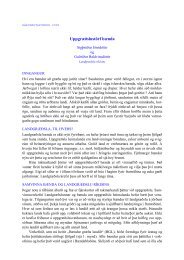Factors involved in ice nucleation and propagation ... - Landbunadur.is
Factors involved in ice nucleation and propagation ... - Landbunadur.is
Factors involved in ice nucleation and propagation ... - Landbunadur.is
You also want an ePaper? Increase the reach of your titles
YUMPU automatically turns print PDFs into web optimized ePapers that Google loves.
46 BÚVÍSINDI<br />
et al., 2000). Interest<strong>in</strong>gly, when acclimated<br />
canola plants were allowed to supercool to<br />
low temperatures (–12 to –15°C) <strong>and</strong> then frozen,<br />
they exhibited no <strong>in</strong>jury despite the rapid<br />
rate of <strong>ice</strong> formation <strong>and</strong> <strong>propagation</strong>. Th<strong>is</strong><br />
<strong>in</strong>dicates that acclimated plants have the ability<br />
to rapidly lose water <strong>in</strong> order to prevent<br />
<strong>in</strong>tracellular <strong>ice</strong> formation. D<strong>is</strong>t<strong>in</strong>ct differences<br />
between acclimated <strong>and</strong> non-acclimated rye<br />
plants have also been observed that may be<br />
attributed to the presence or absence of antifreeze<br />
prote<strong>in</strong>s.<br />
REFERENCES<br />
Andrews, P.K., C.R. S<strong>and</strong>ridge & T.K. Toyama,<br />
1984. Deep supercool<strong>in</strong>g of dormant <strong>and</strong> deacclimat<strong>in</strong>g<br />
Vit<strong>is</strong> buds. American Journal of Enology<br />
<strong>and</strong> Viticulture 35: 175–177.<br />
Ashworth, E.N., 1992. Formation <strong>and</strong> spread of<br />
<strong>ice</strong> <strong>in</strong> plant t<strong>is</strong>sues. Horticulture Reviews 13:<br />
215–255.<br />
Ashworth, E.N. & T.L. Kieft, 1995. Ice <strong>nucleation</strong><br />
activity associated with plants <strong>and</strong> fungi.<br />
In: Biological Ice Nucleation <strong>and</strong> Its Applications<br />
(eds R.E. Lee Jr, G.J. Warren & L.V. Gusta).<br />
APS Press: 137–162.<br />
Ashworth, E.N., J.A. Anderson, G.A. Dav<strong>is</strong> &<br />
G.W. Lightner, 1985. Ice formation <strong>in</strong> Prunus<br />
persica under field conditions. Journal of the<br />
American Society for Horticultural Science 110:<br />
322–324.<br />
Burke, M.J., L.V. Gusta, H.A. Quamme, C.J.<br />
We<strong>is</strong>er & P.H. Li, 1976. Freez<strong>in</strong>g <strong>in</strong>jury <strong>in</strong> plants.<br />
Annual Review of Plant Physioliology 27: 507–<br />
528.<br />
Carter, J., R. Brennan & M. W<strong>is</strong>niewski, 1999.<br />
Low-temperature tolerance of blackcurrant flowers.<br />
HortScience 34: 855–859.<br />
Cary, J.W. & H.F. Mayl<strong>and</strong>, 1970. <strong>Factors</strong> <strong>in</strong>fluenc<strong>in</strong>g<br />
freez<strong>in</strong>g of supercooled water <strong>in</strong> tender<br />
plants. Agronomy Journal 62: 715–719.<br />
Ceccardi, T.L., R.L. Heath & I.P. T<strong>in</strong>g, 1995.<br />
Low-temperature exotherm measurement us<strong>in</strong>g<br />
<strong>in</strong>frared thermography. HortScience 30: 140–<br />
142.<br />
Franks, F., 1985. Biophysics <strong>and</strong> Biochem<strong>is</strong>try at<br />
Low Temperatures. Cambridge University Press:<br />
210 pp.<br />
Fuller, M.P. & M. W<strong>is</strong>niewski, 1998. The use of<br />
<strong>in</strong>frared thermal imag<strong>in</strong>g <strong>in</strong> the study of <strong>ice</strong> nu-<br />
cleation <strong>and</strong> freez<strong>in</strong>g <strong>in</strong> plants. Journal of Thermal<br />
Biology 23: 81–89.<br />
Fuller, M.P., G.G. White & A. Charman, 1994.<br />
The freez<strong>in</strong>g character<strong>is</strong>tics of cauliflower curd.<br />
Annals of Applied Biology 125: 179–188.<br />
Gross, D.C., E.L. Proebst<strong>in</strong>g Jr & P.K. Andrews,<br />
1984. The effects of <strong>ice</strong>-<strong>nucleation</strong>-active bacteria<br />
on the temperatures of <strong>ice</strong> <strong>nucleation</strong> <strong>and</strong><br />
low temperature susceptibilities of Prunus flower<br />
buds at various stages of development. Journal<br />
of the American Society for Horticultural Science<br />
109: 375–380.<br />
Gross, D.C., E.L. Proebst<strong>in</strong>g Jr & H. MacCr<strong>in</strong>dle-<br />
Zimmerman, 1988. Development, d<strong>is</strong>tribution,<br />
<strong>and</strong> character<strong>is</strong>tics of <strong>in</strong>tr<strong>in</strong>sic, non-bacterial <strong>ice</strong><br />
nuclei <strong>in</strong> Prunus wood. Plant Physiology 88:<br />
915–922.<br />
Hirano, S.S., L.S. Baker & C.D. Upper, 1985.<br />
Ice <strong>nucleation</strong> temperature of <strong>in</strong>dividual leaves<br />
<strong>in</strong> relation to population sizes of <strong>ice</strong> <strong>nucleation</strong><br />
active bacteria <strong>and</strong> frost <strong>in</strong>jury. Plant Physiology<br />
77: 259–265.<br />
LeGr<strong>ice</strong>, P., M.P. Fuller & A. Campbell, 1993.<br />
An <strong>in</strong>vestigation of the potential use of thermal<br />
imag<strong>in</strong>g technology <strong>in</strong> the study of frost damage<br />
to sensitive crops. In: 6th International Conference<br />
on Biological Ice Nucleation, University of<br />
Wyom<strong>in</strong>g, Laramie, 4–6 August, 1993: 4.<br />
L<strong>in</strong>dow, S.E., 1983. The role of bacterial <strong>ice</strong> <strong>nucleation</strong><br />
<strong>in</strong> frost <strong>in</strong>jury to plants. Annual Review<br />
of Phytopathology 21: 363–384.<br />
L<strong>in</strong>dow, S.E., 1995. Control of epiphytic <strong>ice</strong>-<strong>nucleation</strong>-active<br />
bacteria for management of plant<br />
frost <strong>in</strong>jury. In: Biological Ice Nucleation <strong>and</strong><br />
Its Applications (eds R.E. Lee Jr, G.J. Warren &<br />
L.V. Gusta). APS Press: 239–256.<br />
L<strong>in</strong>dow, S.E., D.C. Arny & C.D. Upper, 1978.<br />
D<strong>is</strong>tribution of <strong>ice</strong>-<strong>nucleation</strong>-active bacteria on<br />
plants <strong>in</strong> nature. Applied <strong>and</strong> Environmental Microbiology<br />
36: 831–838.<br />
Proebst<strong>in</strong>g, E.L., Jr, P.K. Andrews & D. Gross,<br />
1982. Supercool<strong>in</strong>g <strong>in</strong> young develop<strong>in</strong>g fruit<br />
<strong>and</strong> flower buds <strong>in</strong> deciduous orchards. Hort-<br />
Science 17: 67–68.<br />
Quamme, H.A., C . Stushnoff & C.J. We<strong>is</strong>er,<br />
1972. The relationship of exotherms to cold <strong>in</strong>jury<br />
<strong>in</strong> apple stem t<strong>is</strong>sues. Journal of the American<br />
Society for Horticultural Science 97: 608–<br />
613.<br />
Tao, H., M. W<strong>is</strong>niewski, D. Zarka, M. Thomashow<br />
& J. Duman, 2000. Expression of <strong>in</strong>sect,<br />
Dendroides canadens<strong>is</strong>, antifreeze prote<strong>in</strong> <strong>in</strong> a
















